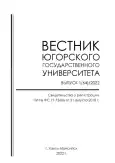Comparative analysis of the implementation of the programs of sustainable development of the SIPN in the Northernand Arctic regions of Russia and the world
- Authors: Mikhailyuk O.N.1, Burundukova E.M.2
-
Affiliations:
- Ural State Mining University
- Yugra State University
- Issue: Vol 18, No 1 (2022)
- Pages: 155-165
- Section: ECONOMY OF THE NORTHERN REGIONS
- Published: 10.05.2022
- URL: https://vestnikugrasu.org/byusu/article/view/107256
- DOI: https://doi.org/10.18822/byusu202201155-165
- ID: 107256
Cite item
Full Text
Abstract
In the last decade, in connection with the industrial development of the northern and Arctic territories, the question arises of preserving the original unique culture of the indigenous peoples of the North (Indigenous Peoples of the North), leading a tribal and semi-tribal way of life. Topical in the light of the increased importance of the Arctic territories of the northern countries today are the issues of protecting the social rights of the indigenous peoples, including the preservation of traditional nature management and the life of ethno-cultural communities. Since the late 1980s to date, important international legal acts have been adopted regarding peoples leading a tribal and nomadic lifestyle: International Convention No. 169 of the International Labor Organization (1989); Kari-Oka Declaration and Charter of the World's Aboriginal Peoples (1992); UN Convention on Biological Diversity (1993); United Nations Declaration on the Rights of Indigenous Peoples (2007). These legal acts significantly increased the rating of the indigenous peoples of the North, raising the problem of their preservation to the level of global importance, and necessitated the development of a support policy. Let us consider the experience of supporting indigenous peoples on the example of countries where the proportion of such a population occupies a significant share (Canada and Norway), as well as the experience of the northern territories of Russia.
About the authors
Oksana N. Mikhailyuk
Ural State Mining University
Author for correspondence.
Email: O_Mikhajluk@mail.ru
Doctor of Economic Sciences, Professor of the Department of Strategic and Production Management
Russian Federation, YekaterinburgElena M. Burundukova
Yugra State University
Email: burundukova@mail.ru
Candidate of Economic Sciences, Director of the Institute of Digital Economy
Russian Federation, Khanty-MansiyskReferences
- Корчак, Е. А. Коренные народы Севера в государственных арктических стратегиях / Е. А. Корчак. – Текст : электронный // Современные проблемы науки и образования. – URL: https://science-education.ru/ru/article/view?id=10096 (дата обращения: 25.11.2021).
- Соколова, Ф. Х. Коренные малочисленные народы Арктики: концепт, современное состояние культуры / Ф. Х. Соколова. – Текст : электронный // Арктика и Север. – 2013. – URL: https://cyberleninka.ru/article/n/korennye-malochislennye-narody-arktiki-kontsept-sovremennoe-sostoyanie-kultury (дата обращения: 25.11.2021).
- О гарантиях прав коренных малочисленных народов Российской Федерации : федеральный закон от 30.04.1999 № 82-ФЗ. – Текст : электронный // Гарант. – URL: https://base.garant.ru/180406/ (дата обращения: 25.11.2021).
- Доклад о развитии человека в Арктике. – Текст : электронный // Stofnun Vilhjálms Stefánssonar. – URL: http://www.svs.is/ahdr/ahdr%20chapters/russian%20version/02_Demographia.pdf (дата обращения: 25.11.2021).
- Население Исландии. – Текст : электронный // Statistics Iceland. – URL: http://www.statice.is/statistics/population (дата обращения: 25.11.2021).
- Rosenberg, M. Current Population of the United States / M. Rosenberg // ThoughtCo. – URL: http://geography.about.com/od/obtainpopulationdata/a/uspopulation.htm (date of application: 25.11.2021).
- The Canadian Population in 2011: Population Counts and Growth // Statistics Canada. – URL: http://www12.statcan.gc.ca/census-recensement/2011/as-sa/98-310-x/98-310-x2011001-eng.cfm (date of application: 25.11.2021).
- Гренландия. Статистика. – Текст : электронный // TopGlobus. – URL: http://www.topglobus.ru/grenlandija-statistika-dannye-strana (дата обращения: 25.11.2021).
- Образование коренных народов в Норвегии. Свейн Ланд. – Текст : электронный // Unesco. – URL: http://www.unesco.org/education/uie/pdf/Norway.pdf (дата обращения: 25.09.2021).
- Статистика Финляндии. – URL: http://www.stat.fi/til/vrm.html (дата обращения: 25.11.2021).
- Численность и состав населения. Федеральная служба государственной статистики. – URL: http://www.stat.fi/til/vrm.html (дата обращения: 25.11.2021).
- Правовые основы обеспечения прав коренных народов Канады и России : учебное пособие / под редакцией А. Ф. Малого, С. В. Бухмина. – Казань : Издательство Казанского университета, 2019. – 160 с. – Текст : непосредственный.
- Арктические и Северные территории Канады. – Текст : электронный // Arctic Council. – URL: https://arctic-council.org/ru/about/states/canada/ (дата обращения: 25.11.2021).
- Crown-Indigenous Relations and Northern Affairs Canada // Government of Canada. – URL: https://www.canada.ca/en/crown-indigenous-relations-northern-affairs.html (date of application: 25.11.2021).
- Budget 2020: Arctic and Northern Summary // Government of Canada. – URL: https://www.rcaanccirnac.gc.ca/eng/1562853124135/1562853167783 (date of application: 25.11.2021).
- Territorial Formula Financing // Government of Canada. – URL: https://www.canada.ca/en/department-finance/programs/federal-transfers/territorial-formula-financing.html (date of application: 25.11.2021).
- Сахаров, А. Г. Устойчивое развитие арктических территорий Канады: цели и результаты / А. Г. Сахаров, И. В. Андронова. – Текст : непосредственный // Вестник международных организаций. – 2020. – Т. 15, № 4. – С. 140–162.
- Норвегия и Арктический регион. – Текст : электронный // Arctic Council. – URL: https://arctic-council.org/ru/about/states/norway/ (дата обращения: 25.11.2021).
- Мороз, Е. Н. Реализация прав коренных народов на примере политики Норвегии в от-ношении саамского населения / Е. Н. Мороз. – Текст : непосредственный // Политика и Общество. – 2021. – № 1. – С. 41–49.
- Sametingets budsjett 2020. Vedtatt 5. desember 2019. Sak 52/19 // Sámediggi: Sametinget. – URL: https://sametinget.no/_f/p1/i30a40103-03ca-41ba-bcfb-fd3cdc9dc306/sametingets-budsjett-2020-norsk-1.pdf (date of application: 25.11.2021).
- О государственной программе Ханты-Мансийского автономного округа – Югры «Устойчивое развитие коренных малочисленных народов Севера» : постановление Правительства Ханты-Мансийского автономного округа – Югры от 5 октября 2018 года № 350-п. – Текст : электронный // Электронный фонда правовых и нормативно-технических документов. – URL: https://docs.cntd.ru/document/550199962 (дата обращения: 25.11.2021).
- Отчет Губернатора Ханты-Мансийского автономного округа – Югры о результатах деятельности Правительства Ханты-Мансийского автономного округа – Югры за 2020 год. – Текст : электронный // Стратегия24. – URL: https://storage.strategy24.ru/files/news/202011/703f4c73a2ef3178c0ad0294449b6e70.pdf (дата обраще-ния: 25.11.2021).
- Отчет по реализации Стратегии социально-экономического района Ханты-Мансийского района до 2030 года. Текст : электронный // Ханты-Мансийский район, официальный сайт администрации. – URL: http://hmrn.ru/raion/ekonomika/ser/strategy/otchet-2030-vizual.php (дата обращения: 25.11.2021).
- Меры государственной поддержки коренных малочисленных народов Севера согласно Постановлению Правительства Ханты-Мансийского автономного округа – Югры от 05.10.2018 № 350-п «О государственной программе Ханты-Мансийского автономного округа – Югры «Устойчивое развитие коренных малочисленных народов Севера». – Текст : электронный // Официальный сайт октябрьского района ХМАО-Югры. – URL: http://oktregion.ru/upload/docs/ekonomika-i-finansy/razvitie-korennykh-malochislennykh-narodov-severa/Mery_gos_poddergki_KMNS-1.pdf (дата обращения: 25.11.2021).
Supplementary files







